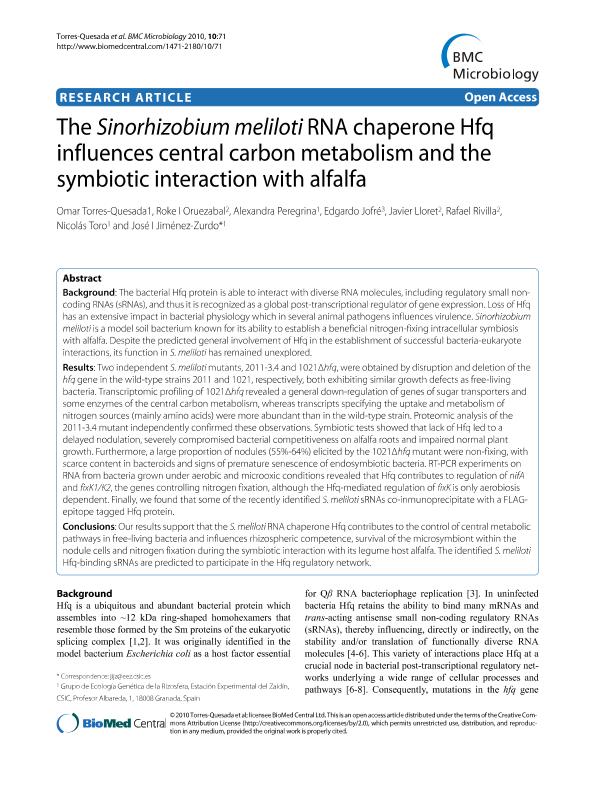Mostrar el registro sencillo del ítem
dc.contributor.author
Torres Quesada, Omar
dc.contributor.author
Oruezabal, Roke I.
dc.contributor.author
Peregrina, Alexandra
dc.contributor.author
Jofré, Edgardo

dc.contributor.author
Lloret, Javier
dc.contributor.author
Rivilla, Rafael
dc.contributor.author
Toro, Nicolás
dc.contributor.author
Jiménez Zurdo, José I.
dc.date.available
2021-04-09T20:03:30Z
dc.date.issued
2010-03
dc.identifier.citation
Torres Quesada, Omar; Oruezabal, Roke I.; Peregrina, Alexandra; Jofré, Edgardo; Lloret, Javier; et al.; The Sinorhizobium meliloti RNA chaperone Hfq influences central carbon metabolism and the symbiotic interaction with alfalfa; BioMed Central; BMC Microbiology; 10; 71; 3-2010; 1-20
dc.identifier.issn
1471-2180
dc.identifier.uri
http://hdl.handle.net/11336/129750
dc.description.abstract
Background. The bacterial Hfq protein is able to interact with diverse RNA molecules, including regulatory small non-coding RNAs (sRNAs), and thus it is recognized as a global post-transcriptional regulator of gene expression. Loss of Hfq has an extensive impact in bacterial physiology which in several animal pathogens influences virulence. Sinorhizobium meliloti is a model soil bacterium known for its ability to establish a beneficial nitrogen-fixing intracellular symbiosis with alfalfa. Despite the predicted general involvement of Hfq in the establishment of successful bacteria-eukaryote interactions, its function in S. meliloti has remained unexplored. Results. Two independent S. meliloti mutants, 2011-3.4 and 1021hfq, were obtained by disruption and deletion of the hfq gene in the wild-type strains 2011 and 1021, respectively, both exhibiting similar growth defects as free-living bacteria. Transcriptomic profiling of 1021hfq revealed a general down-regulation of genes of sugar transporters and some enzymes of the central carbon metabolism, whereas transcripts specifying the uptake and metabolism of nitrogen sources (mainly amino acids) were more abundant than in the wild-type strain. Proteomic analysis of the 2011-3.4 mutant independently confirmed these observations. Symbiotic tests showed that lack of Hfq led to a delayed nodulation, severely compromised bacterial competitiveness on alfalfa roots and impaired normal plant growth. Furthermore, a large proportion of nodules (55%-64%) elicited by the 1021hfq mutant were non-fixing, with scarce content in bacteroids and signs of premature senescence of endosymbiotic bacteria. RT-PCR experiments on RNA from bacteria grown under aerobic and microoxic conditions revealed that Hfq contributes to regulation of nifA and fixK1/K2, the genes controlling nitrogen fixation, although the Hfq-mediated regulation of fixK is only aerobiosis dependent. Finally, we found that some of the recently identified S. meliloti sRNAs co-inmunoprecipitate with a FLAG-epitope tagged Hfq protein. Conclusions. Our results support that the S. meliloti RNA chaperone Hfq contributes to the control of central metabolic pathways in free-living bacteria and influences rhizospheric competence, survival of the microsymbiont within the nodule cells and nitrogen fixation during the symbiotic interaction with its legume host alfalfa. The identified S. meliloti Hfq-binding sRNAs are predicted to participate in the Hfq regulatory network. © 2010 Torres-Quesada et al; licensee BioMed Central Ltd.
dc.format
application/pdf
dc.language.iso
eng
dc.publisher
BioMed Central

dc.rights
info:eu-repo/semantics/openAccess
dc.rights.uri
https://creativecommons.org/licenses/by/2.5/ar/
dc.subject
Sinorhizobium meliloti
dc.subject
RNA chaperone
dc.subject
Hfq
dc.subject
symbiosis
dc.subject.classification
Biología Celular, Microbiología

dc.subject.classification
Ciencias Biológicas

dc.subject.classification
CIENCIAS NATURALES Y EXACTAS

dc.title
The Sinorhizobium meliloti RNA chaperone Hfq influences central carbon metabolism and the symbiotic interaction with alfalfa
dc.type
info:eu-repo/semantics/article
dc.type
info:ar-repo/semantics/artículo
dc.type
info:eu-repo/semantics/publishedVersion
dc.date.updated
2021-04-09T16:18:34Z
dc.journal.volume
10
dc.journal.number
71
dc.journal.pagination
1-20
dc.journal.pais
Reino Unido

dc.journal.ciudad
Londres
dc.description.fil
Fil: Torres Quesada, Omar. Consejo Superior de Investigaciones Científicas. Estación Experimental del Zaidín; España
dc.description.fil
Fil: Oruezabal, Roke I.. Universidad Autónoma de Madrid; España
dc.description.fil
Fil: Peregrina, Alexandra. Consejo Superior de Investigaciones Científicas. Estación Experimental del Zaidín; España
dc.description.fil
Fil: Jofré, Edgardo. Universidad Nacional de Río Cuarto. Facultad de Ciencias Exactas Fisicoquímicas y Naturales; Argentina. Consejo Nacional de Investigaciones Científicas y Técnicas. Centro Científico Tecnológico Conicet - Córdoba; Argentina
dc.description.fil
Fil: Lloret, Javier. Universidad Autónoma de Madrid; España
dc.description.fil
Fil: Rivilla, Rafael. Universidad Autónoma de Madrid; España
dc.description.fil
Fil: Toro, Nicolás. Consejo Superior de Investigaciones Científicas. Estación Experimental del Zaidín; España
dc.description.fil
Fil: Jiménez Zurdo, José I.. Consejo Superior de Investigaciones Científicas. Estación Experimental del Zaidín; España
dc.journal.title
BMC Microbiology

dc.relation.alternativeid
info:eu-repo/semantics/altIdentifier/doi/http://dx.doi.org/10.1186/1471-2180-10-71
dc.relation.alternativeid
info:eu-repo/semantics/altIdentifier/url/https://bmcmicrobiol.biomedcentral.com/articles/10.1186/1471-2180-10-71
Archivos asociados
